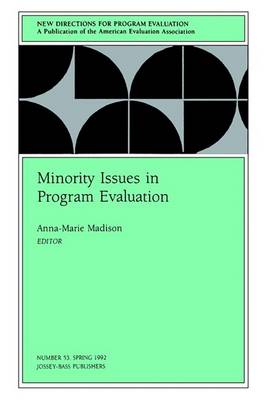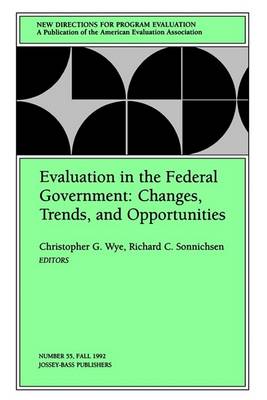New Directions for Performance Evaluation S.
2 primary works
Book 53
A significant report on a critical topic, this classic volume of the New Directions for Evaluation series is now in print and available again. Racial and ethnic minorities are disproportionately the beneficiaries of many of the social programs evaluators are called upon to evaluate, yet they generally have little influence in defining the goals of these programs or in determining how the programs' real impact on their lives will be measured. The contributors to this volume contend that this lack of input reduces the effectiveness of both the programs and evaluators' attempts to analyze them, and offer a variety of approaches for addressing dominant-culture bias program design and evaluation. The first chapter offers a case study of an evaluation of education reform in Texas in which individuals targeted by the program were involved in its evaluation. The second chapter examines a multicultural education program in which individuals from the targeted minority communities were involved in every step of the process, from program planning and design through evaluation.
The last four chapters focus on specific methodological issues, including correcting cultural bias in standardized testing, the use (and misuse) of race as an explanatory variable in program evaluation, and dealing with the many cultural bias-related issues inherent in the evaluation of multicultural education programs. This is the 53rd volume of the Jossey-Bass quarterly report series New Directions for Evaluation.
The last four chapters focus on specific methodological issues, including correcting cultural bias in standardized testing, the use (and misuse) of race as an explanatory variable in program evaluation, and dealing with the many cultural bias-related issues inherent in the evaluation of multicultural education programs. This is the 53rd volume of the Jossey-Bass quarterly report series New Directions for Evaluation.
Book 55
A significant report on a critical topic, this classic volume of the New Directions for Evaluation series is now in print and available again. This issue, which includes government documents pertaining to evaluation as well as contributions from federal evaluators and administrators, outlines the duties, responsibilities, and methodological approaches of the various government offices with evaluative functions, and details some of the strategies used by these agencies to cope with the twin pressures of reduced funding and greater calls to demonstrate the effectiveness of government programs pressures first felt in the 1980s and which continue to the present day.
The contributors discuss federal evaluation agencies in three broad categories: executive branch social agencies, such as the Department of Health and Human Services and the Department of Housing and Urban Development, where the cutbacks were the most severe; the three so-called central executive branch agencies the Office of Management and Budget, the Office of Personnel Management, and the General Services Administration where cutbacks were less severe but still significant, and where attitudes towards evaluation varied over time; and the evaluative agencies of the legislative branch the General Accounting Office, the Congressional Budget Office, the Congressional Research Service, and the Office of Technology Assessment where evaluation remained fairly robust and well-funded. This is the 55th volume of the quarterly report series New Directions for Evaluation.
The contributors discuss federal evaluation agencies in three broad categories: executive branch social agencies, such as the Department of Health and Human Services and the Department of Housing and Urban Development, where the cutbacks were the most severe; the three so-called central executive branch agencies the Office of Management and Budget, the Office of Personnel Management, and the General Services Administration where cutbacks were less severe but still significant, and where attitudes towards evaluation varied over time; and the evaluative agencies of the legislative branch the General Accounting Office, the Congressional Budget Office, the Congressional Research Service, and the Office of Technology Assessment where evaluation remained fairly robust and well-funded. This is the 55th volume of the quarterly report series New Directions for Evaluation.

